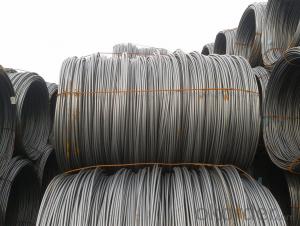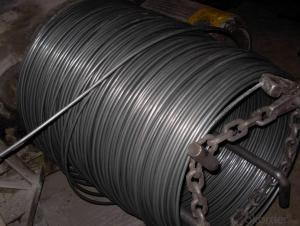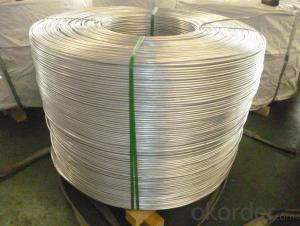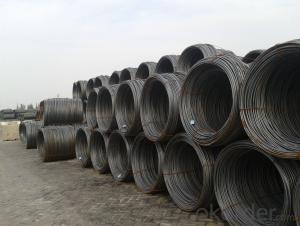SAE1006Cr Carbon Steel Wire Rod 14mm for Welding
- Loading Port:
- Shanghai
- Payment Terms:
- TT OR LC
- Min Order Qty:
- 100 m.t
- Supply Capability:
- 30000 m.t/month
OKorder Service Pledge
OKorder Financial Service
You Might Also Like
Item specifice
Description of SAE1006Cr Carbon Steel Wire Rod 14mm for Welding:
OKorder is offering Color Coated Steel Coil Prepainted Steel Coil at great prices with worldwide shipping. Our supplier is a world-class manufacturer of steel, with our products utilized the world over. OKorder annually supplies products to European, North American and Asian markets. We provide quotations within 24 hours of receiving an inquiry and guarantee competitive prices.
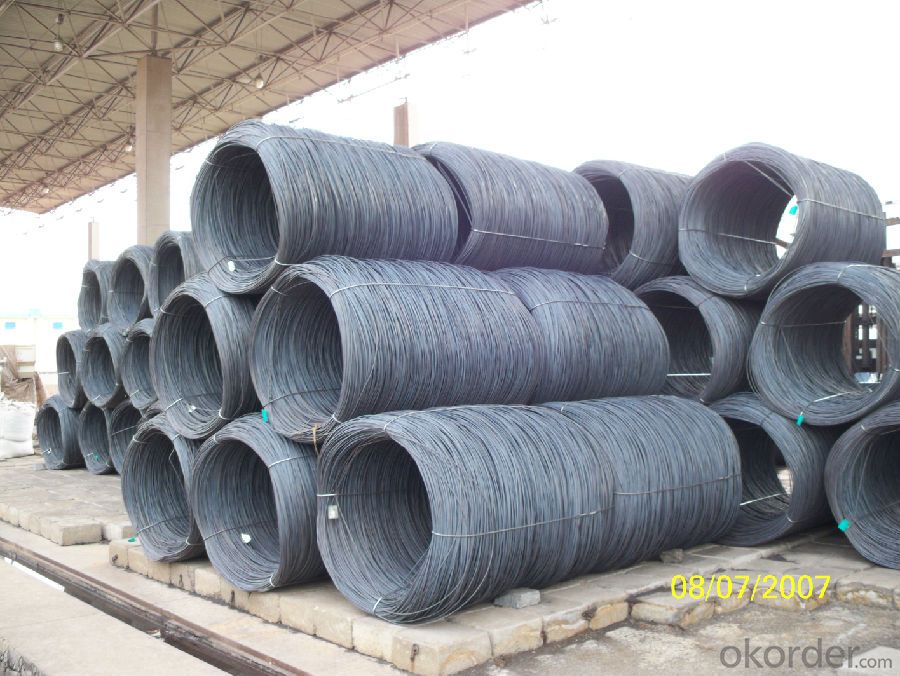
Applications of SAE1006Cr Carbon Steel Wire Rod 14mm for Welding:
Color Coated Steel Coil Prepainted Steel Coil are ideal for structural applications and are widely used in the construction of buildings and bridges, and the manufacturing, petrochemical, and transportation industries.
Main Product Features of SAE1006Cr Carbon Steel Wire Rod 14mm for Welding:
· Premium quality
· Prompt delivery & seaworthy packing (30 days after receiving deposit)
· Corrosion resistance
· Can be recycled and reused
· Mill test certification
· Professional Service
· Competitive pricing
Specifications of SAE1006Cr Carbon Steel Wire Rod 14mm for Welding:
1, Introduction: Color coated steel coils(sheets), i. E. PPGI, also called prepainted steel coils(sheets), are made of galvanized steel coils(sheets) with polymer coatings as surface. It's a new enclosure material and building board with characteristics of light-weighted, heat preserved&insulated, easily installed with bright colors.
2, Production Process: Pretreatment(Degreasing)_Drying_Chromating_Paint Basic Oil_Cooling_Drying_Color Coating_Cooling_Film-covering_Rolling Up
3, Characteristics:
Good at corrosion resistence. Besides zinc coating of the basic plate of galvanized steel sheet, the color coating as the surface has double lifetime to ensure better anticorrosion effect.
With excellent cold bending molded manufacturablity, PPGI products can be processed or directly used as final product. As being light-weighted and conveniently transported, they're widly used to replace wood to save energy.
4.There're thousands of colors can be chosen as per different application. Any color plays well in decoration.
No pollution with high recycling rate, PPGI coils and sheets are strongly recommended as enviroment-friendly products by the government.
5, eye bands and 4 circumferential bands in steel, galvanized metal fluted rings on inner and outer edges, galvanized.
| commodity | SAE1006Cr Carbon Steel Wire Rod 14mm for Welding |
| Techinical Standard: | JIS G3302-1998, EN10142/10137, ASTM A755 |
| grade | Q195,Q215,Q235,SAE1006,SAE1008 SAE1006Cr |
| Types: | Mesh welding |
| Base metal | galvanized, galvalume, cold rolled steel |
| Thickness | 0.14-1.0mm(0.16-0.8mm is the most advantage thickness) |
| Width | 610/724/820/914/1000/1200/1219/1220/1250mm |
| Type of coating: | PE, SMP, PVDF |
| Zinc coating | Z60-150g/m2 or AZ40-100g/m2 |
| Top painting: | 5 mic. Primer + 15 mc. R. M. P. |
| Back painting: | 5-7 mic. EP |
| Color: | According to RAL standard |
| ID coil | 508mm610mm |
| Coil weight: | 2--3MT |
| Package: | Properly packed for ocean freight exportation in 20'containers |
| Application: | Industrial panels, roofing and siding for painting/automobile |
| Price terms | FOB, CFR, CIF |
| Payment terms | 20%TT in advance+80% TT or irrevocable 80%L/C at sight |
| delivery time | 25 days after recepit of 20% TT |
| Remarks | Insurance is all risks |
| MTC 3.1 will be handed on with shipping documents | |
| We accept SGS certificatation test |
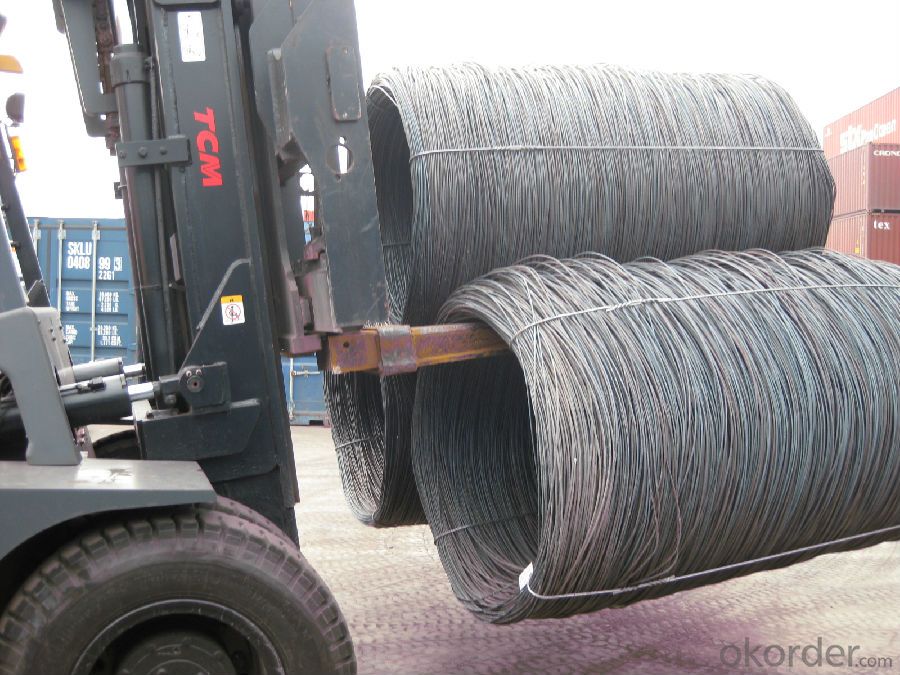
FAQ of SAE1006Cr Carbon Steel Wire Rod 14mm for Welding:
Q1: Why buy Materials & Equipment from OKorder.com?
A1: All products offered byOKorder.com are carefully selected from China's most reliable manufacturing enterprises. Through its ISO certifications, OKorder.com adheres to the highest standards and a commitment to supply chain safety and customer satisfaction.
Q2: How do we guarantee the quality of our products?
A2: We have established an advanced quality management system which conducts strict quality tests at every step, from raw materials to the final product. At the same time, we provide extensive follow-up service assurances as required.
Q3: How soon can we receive the product after purchase?
A3: Within three days of placing an order, we will begin production. The specific shipping date is dependent upon international and government factors, but is typically 7 to 10 workdays.
Q4: What makes stainless steel stainless?
A4: Stainless steel must contain at least 10.5 % chromium. It is this element that reacts with the oxygen in the air to form a complex chrome-oxide surface layer that is invisible but strong enough to prevent further oxygen from "staining" (rusting) the surface. Higher levels of chromium and the addition of other alloying elements such as nickel and molybdenum enhance this surface layer and improve the corrosion resistance of the stainless material.
Q5: Can stainless steel rust?
A5: Stainless does not "rust" as you think of regular steel rusting with a red oxide on the surface that flakes off. If you see red rust it is probably due to some iron particles that have contaminated the surface of the stainless steel and it is these iron particles that are rusting. Look at the source of the rusting and see if you can remove it from the surface.
- Q:How is steel wire rod used in the manufacturing of wire forms for security fencing?
- Steel wire rod is used in the manufacturing of wire forms for security fencing by being processed through various stages such as drawing, annealing, and coating to obtain the desired strength, flexibility, and corrosion resistance. This rod is then shaped and welded into different wire forms, such as mesh panels or barbed wire, which are essential components of security fencing.
- Q:What are the different straightening methods for steel wire rod?
- There exists a range of techniques for straightening steel wire rods, each tailored to achieve specific outcomes based on the desired level of straightness and the type of wire being processed. Some commonly employed methods in the industry include: 1. Mechanical straightening: This approach entails guiding the wire rod through a sequence of straightening rolls or dies positioned at various angles. These rolls or dies exert pressure on the wire, gradually bending it back into a straight form. Mechanical straightening is frequently utilized for low carbon steel wire rods. 2. Thermal straightening: In this method, the wire rod is heated to a specific temperature and then rapidly cooled, causing the metal to contract and straighten. Typically, the wire is passed through a series of water or air cooling chambers to obtain the desired straightness. Thermal straightening is generally employed for medium to high carbon steel wire rods. 3. Hydraulic straightening: This technique employs hydraulic cylinders to apply pressure to the wire, straightening it by bending it in the opposite direction of its natural curve. Hydraulic straightening can be used for various types of steel wire rods, but it is particularly effective for high-strength wires. 4. Rotary straightening: Also known as rotary swaging, this method involves placing the wire rod in a rotating drum or cage containing a series of tapered rolls. As the wire passes through the rolls, it gradually straightens due to the forces exerted by the rotating rolls. Rotary straightening is commonly used for stainless steel wire rods and other high-alloy materials. 5. Combination methods: Some manufacturers employ a combination of different straightening methods to achieve the desired results. For instance, a wire rod may undergo initial mechanical straightening followed by thermal straightening to further enhance its straightness. It is important to note that the choice of straightening method depends on various factors, including the type of steel wire rod, its diameter and tensile strength, and the desired level of straightness. Additionally, each method has its own advantages and limitations, making it crucial to select the most suitable method based on the specific requirements of the wire rod application.
- Q:How is steel wire rod used in the manufacturing of fences?
- Steel wire rod is used in the manufacturing of fences as it serves as the primary material for creating the wire mesh that forms the structure of the fence. The steel wire rod is carefully shaped, twisted, and woven together to create a strong and durable fencing material that provides security and containment. It is commonly used for various types of fences, including chain-link fences, welded wire fences, and agricultural fences, due to its high tensile strength and resistance to weathering and corrosion.
- Q:How is steel wire rod used in the manufacturing of wire forms for lighting fixtures?
- Wire forms for lighting fixtures rely on steel wire rod as a crucial component in their production. This wire rod serves as the primary raw material for crafting various wire forms, such as hooks, frames, and brackets, which are integral to the structure and functionality of lighting fixtures. The manufacturing process of steel wire rod begins with a series of steps. Initially, the wire rod undergoes wire drawing, wherein it is drawn through a series of dies to decrease its diameter and increase its length. This process results in a wire that is smooth, uniform, and of the desired thickness. After the wire has been drawn, it undergoes further processing to create the specific wire forms needed for lighting fixtures. This involves bending, shaping, and cutting the wire to the desired dimensions. To achieve the desired shapes and sizes, various tools and equipment, such as wire forming machines and presses, are utilized. The wire forms crafted from the steel wire rod are then integrated into the production of lighting fixtures. For example, hooks made from these wire forms are used to suspend the fixtures from the ceiling or wall mountings. Frames created from the wire forms provide structural support and hold the components of the lighting fixture in place. Brackets made from the wire forms are employed to attach the fixture to the wall or ceiling. Furthermore, the wire forms made from steel wire rod often serve as decorative elements in lighting fixtures. These wire forms can be shaped into intricate designs and patterns that enhance the aesthetics of the fixture. Various curves, loops, and spirals can be formed to create visually appealing and unique lighting designs. In conclusion, steel wire rod plays a vital role in the manufacturing process of wire forms for lighting fixtures. It offers the necessary strength, durability, and versatility required to create functional and visually appealing lighting fixtures.
- Q:What are the different types of wire drawing dies used for steel wire rod?
- There are several types of wire drawing dies that are commonly used for steel wire rod. These include: 1. Single crystal natural diamond dies: These dies are made from a single crystal diamond and are known for their high hardness and wear resistance. They can be used for drawing high carbon steel wire rod as well as stainless steel wire rod. 2. Polycrystalline diamond (PCD) dies: PCD dies are made from multiple small diamond crystals that are bonded together. They offer good wear resistance and can be used for drawing steel wire rod with intermediate carbon content. 3. Tungsten carbide dies: Tungsten carbide is a hard and durable material that is often used for wire drawing dies. These dies can handle high carbon steel wire rod and are known for their ability to withstand high pressures and temperatures. 4. Natural diamond dies with carbide support: These dies have a natural diamond core with a carbide support structure. The diamond provides excellent wear resistance while the carbide support adds strength and stability. They are suitable for drawing steel wire rod with high carbon content. 5. PCD dies with carbide support: Similar to the above, these dies have a PCD core with a carbide support structure. They offer good wear resistance and can handle steel wire rod with intermediate carbon content. 6. Polycrystalline diamond composite (PDC) dies: PDC dies are made by sintering diamond particles with a binder material. They are known for their high wear resistance and are often used for drawing steel wire rod with low to medium carbon content. Each type of wire drawing die has its own advantages and is suitable for specific applications based on the carbon content and other properties of the steel wire rod being drawn.
- Q:How are steel wire rods used in the production of wire springs?
- Wire springs rely heavily on steel wire rods, which are melted and shaped into cylindrical forms through rolling. The resulting rods are then drawn through dies to decrease their diameter and increase their length, imparting strength and flexibility. This process ensures the suitability of the wire rods for spring usage. After the drawing process, the steel wire rods are commonly coiled onto large spools or reels. These coiled wires are then fed into machines that manufacture springs. The wire is cut to the desired length and shaped into different spring forms, such as helical coils or conical shapes. The inherent strength and elasticity of steel wire rods make them highly suitable for wire springs. These springs find extensive applications in various industries, including automotive suspensions, furniture, industrial machinery, and household appliances. The steel wire rods provide the necessary tensile strength and resilience to endure the forces and stresses experienced in these applications. To sum up, steel wire rods play a crucial role in the production of wire springs, providing the strength, flexibility, and resilience required for effective functioning in diverse industries and applications.
- Q:What are the common alloying elements in steel wire rod?
- The common alloying elements in steel wire rod are carbon, manganese, silicon, and sometimes small amounts of other elements such as chromium, nickel, or molybdenum.
- Q:What are the safety considerations for handling steel wire rod?
- Some safety considerations for handling steel wire rod include wearing appropriate personal protective equipment (PPE) such as gloves, goggles, and steel-toe boots to protect against cuts, eye injuries, and falling objects. It is essential to handle the wire rod with care to avoid injuries caused by sharp edges or protruding ends. Workers should also be trained on proper lifting techniques to prevent strains or back injuries. Additionally, maintaining a clean and organized work area can help reduce the risk of slips, trips, and falls.
- Q:What are the different surface finishing techniques for steel wire rod?
- There are several surface finishing techniques that can be used for steel wire rods. These techniques are employed to enhance the appearance, durability, and functionality of the wire rods. Some of the common surface finishing techniques for steel wire rods include: 1. Galvanizing: This technique involves coating the steel wire rod with a layer of zinc to protect it from corrosion. Galvanizing provides excellent resistance to rust and is commonly used in outdoor applications such as fencing, construction, and automotive industries. 2. Electroplating: In this technique, a thin layer of metal, such as nickel or chrome, is deposited on the surface of the steel wire rod using an electrochemical process. Electroplating can enhance the appearance of the wire rod and provide improved resistance to corrosion. 3. Phosphating: Phosphating is a chemical process that involves the application of a phosphate coating on the steel wire rod's surface. This technique enhances the wire rod's adhesion properties, improves corrosion resistance, and provides a suitable surface for subsequent coating or painting. 4. Pickling: Pickling is a process that removes impurities and scale from the surface of the steel wire rod using an acidic solution. This technique helps to improve the wire rod's surface cleanliness and prepares it for subsequent coating or painting. 5. Powder coating: Powder coating involves applying a dry powder to the surface of the steel wire rod, which is then heated to form a protective and decorative coating. Powder coating provides excellent resistance to corrosion, impact, and UV rays, making it suitable for various applications such as furniture, appliances, and automotive parts. 6. Passivation: Passivation is a chemical process that creates a protective oxide layer on the surface of the steel wire rod to enhance its corrosion resistance. This technique is commonly used for stainless steel wire rods to improve their resistance to rust and maintain their appearance. 7. Anodizing: Anodizing is typically used for aluminum wire rods but can also be applicable to steel wire rods. It involves creating a controlled oxidation process on the surface of the wire rod to form a durable and corrosion-resistant layer. Anodizing can provide various decorative finishes and is commonly used in the construction, aerospace, and automotive industries. These surface finishing techniques offer a wide range of benefits and can be chosen based on the specific requirements of the steel wire rod's application, including aesthetics, corrosion resistance, and durability.
- Q:How does steel wire rod compare to other materials in terms of strength and durability?
- The market widely recognizes steel wire rod as one of the strongest and most durable materials available. When compared to alternatives such as aluminum or copper, steel wire rod stands out for its superior strength and durability. To begin with, steel wire rod possesses exceptional tensile strength, enabling it to endure substantial pulling forces without breaking or deforming. This strength proves crucial in applications where the material faces heavy loads or high-stress conditions. In contrast, aluminum or copper wire rod typically exhibits lower tensile strength, making them more susceptible to deformation or breakage under similar circumstances. Furthermore, steel wire rod showcases remarkable durability owing to its resistance to corrosion, wear, and fatigue. Steel naturally possesses the ability to withstand adverse environmental conditions, making it suitable for various harsh environments, including outdoor or marine applications. Conversely, materials like aluminum or copper are more prone to corrosion and wear, which can compromise their strength and longevity over time. Moreover, steel wire rod offers excellent structural integrity, allowing it to retain its strength and shape even when exposed to extreme temperatures or heavy mechanical stress. This characteristic makes steel wire rod highly suitable for demanding applications where safety and reliability are of paramount importance, such as the construction, automotive, or aerospace industries. In comparison, materials like aluminum or copper may experience greater deformation or loss of strength under similar conditions. In conclusion, steel wire rod surpasses other materials in terms of strength and durability. Its exceptional tensile strength, resistance to corrosion and wear, as well as its ability to withstand extreme conditions, make it the preferred choice in numerous industries. Whether utilized for structural purposes, reinforcement, or support, steel wire rod consistently delivers superior performance, ensuring reliability and longevity in various applications.
1. Manufacturer Overview |
|
|---|---|
| Location | |
| Year Established | |
| Annual Output Value | |
| Main Markets | |
| Company Certifications | |
2. Manufacturer Certificates |
|
|---|---|
| a) Certification Name | |
| Range | |
| Reference | |
| Validity Period | |
3. Manufacturer Capability |
|
|---|---|
| a)Trade Capacity | |
| Nearest Port | |
| Export Percentage | |
| No.of Employees in Trade Department | |
| Language Spoken: | |
| b)Factory Information | |
| Factory Size: | |
| No. of Production Lines | |
| Contract Manufacturing | |
| Product Price Range | |
Send your message to us
SAE1006Cr Carbon Steel Wire Rod 14mm for Welding
- Loading Port:
- Shanghai
- Payment Terms:
- TT OR LC
- Min Order Qty:
- 100 m.t
- Supply Capability:
- 30000 m.t/month
OKorder Service Pledge
OKorder Financial Service
Similar products
New products
Hot products
Related keywords
